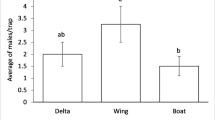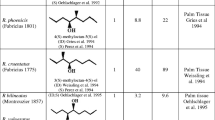Abstract
Field tests were carried out to determine whether pheromone traps, baited with (Z,E)-9,12-tetradecadienyl acetate (Z9,E12-14:Ac) impregnated in rubber septa (Maavit, Israel), could provide a reliable tool for monitoring the raisin moth,Cadra figulilella (Gregson), in date palm plantations. No significant differences were detected between captures of males in traps baited with 1 or 10 mg pheromone/dispenser. However, traps baited with 1 mg pheromone captured significantly more males than those baited with 0.1 mg pheromone/dispenser. No differences were found between captures of males in traps hung at a height of 8 m (near the bunches) or 2–3 m (on palm trunks). Two peaks of male capture were detected, one in May-June and the other during September-October (ripening period). Results indicate a positive relationship between captures in traps and infestation levels by larvae. Pheromone traps baited with 1 mg Z9,E12–14:Ac impregnated in rubber septa and hung on palm trunks (at a height of 2–3 m), were very useful for monitoringC. figulilella populations and for determining the accurate timing of insecticide applications.
Similar content being viewed by others
References
Abou El-Ghar, M.R. and El-Rafie, M.S. (1964) Control measures of date pests in Egypt.Bull. Soc. Entomol. Egypte 48:291–301.
Brady, U.E. and Daley, R.C. (1972) Identification of a sex pheromone from the female raisin mothC. figulilella. Ann. Entomol. Soc. Am. 65:1356–1358.
Burkholder, W.E. (1990) Practical use of pheromones and other attraclants for stored- product insects,in: Ridgeway, R.L., Silverstein, R.M. and Inscoe, M.N. [Eds.] Behavior Modifying Chemicals for Insect Management. Marcel Dekker Inc., New York, NY. pp. 497–516.
Carpenter, J.B. and Elmer, H.S. (1978) Pests and Diseases of the Date Palm. U.S. Dep. Agric. Agric. Handb. 527.
Corbet, A.S. and Tarns, W.H.T. (1943) Keys for the identification of the Lepidoptera infesting stored food products.Proc. Zool. Soc. Lond. Ser. B 113:55–148.
Donahaye, E. and Calderon, M. (1964) Survey of insects infesting dates in storage in Israel. Israel J. Agric. Res. 14:97–100.
Donohoe, H.C., Simmons, P., Barnes, D.F., Kaloostian, G.H., Fisher, C.K. and Heinrick, C. (1949) Biology of the raisin moth.U.S. Dep. Agric. Tech. Bull. 994.
Kehat, M., Blumberg, D. and Greenberg, S. (1969) Experiments on the control of the raisin moth,Cadra figulilella Gregs. (Phycitidae, Pyralidae), on dates in Israel.Israel J. Agric. Res. 19:121–128.
Kehat, M. and Greenberg, S. (1969) The biology and phenology ofArenipses sabella Hmps. andCadra figulilella (Gregson) (Lepidoptera, Pyralidae), on dates in Israel.Bull. Entomol. Res. 58:411–419.
Lindgren, D.L., Bliss, D.E. and Barnes, D.F. (1948) Insect infestations and fungus spoilage — their relation and control.Date Growers’ Inst. Rep. 25:12–17.
Warner, R.L., Barnes, M.N. and Laird, E.F. (1990) Chemical control of a carob moth,Ectomyelois ceratoniae (Lepidoptera: Pyralidae), and various nitidulid beetles (Coleoptera) on ‘Deglet Noor’ dates in California.J. Econ. Entomol. 83:2357–2361.
Author information
Authors and Affiliations
Rights and permissions
About this article
Cite this article
Kehat, M., Eitam, A., Blumberg, D. et al. Sex pheromone traps for detecting and monitoring the raisin moth,cadra figulilella, in date palm plantations. Phytoparasitica 20, 99–106 (1992). https://doi.org/10.1007/BF02981275
Received:
Issue Date:
DOI: https://doi.org/10.1007/BF02981275




